Jyoti Malhotra in New Delhi
Prime Minister Manmohan Singh has overruled the traditional caution of his foreign policy mandarins and in conjunction with commerce and textiles minister Anand Sharma crafted a trade liberalisation initiative with Bangladesh that will be a key element in what promises to be a historic visit to Dhaka beginning Tuesday.
The radical nature of the trade package is sure to take everyone's breath away when Manmohan Singh meets Bangladeshi Prime Minister Sheikh Hasina.
. . .
How India dismantled textile regime with Bangladesh
Image: Prime Minister Manmohan Singh.Photographs: Reuters
Not only because it pretty much dismantles the one-sided trade regime that currently exists with Bangladesh, but also because it is a sure sign of trade and economic reform that the Prime Minister intends to carry out across the Indian sub-continent in the coming weeks.
According to top government sources who spoke on the condition of anonymity, a politically battered Prime Minister is now determined to use India's neighbourhood as his canvas on which to unleash economic reform, especially if he is being repeatedly blocked from doing so at home.
. . .
How India dismantled textile regime with Bangladesh
Image: Bangladesh PM Sheikh Hasina and Manmohan Singh wave to the photographers.Photographs: Reuters
The first brush on the canvas will take place in Bangladesh when the Prime Minister announces that all 48 tariff lines on textiles that exist between the two countries will be dismantled, in deference to Dhaka's request.
Actually, Dhaka had wanted all 61 tariff lines to go, but when officials went looking into the fine print, they found that 13 of those lines pertained to energy-related items such as kerosene, leading to some concern that these could be diverted.
. . .
How India dismantled textile regime with Bangladesh
Image: Mamata Banerjee.Photographs: Reuters
Over the last 24 hours, West Bengal Chief Minister Mamata Banerjee's demands on the Teesta waters threatened to cast a long shadow over the PM's visit, the first by an Indian Prime Minister in 12 years.
Less noticeable but equally significant was the suppressed grumbling by Indian businessmen resounding through the corridors of power, reacting nervously to the dismantling of the proposed tariff lines with Bangladesh.
. . .
How India dismantled textile regime with Bangladesh
Image: Traffic snarl-up in Dhaka.Photographs: Courtesy, Commons Wikimedia
But at a press conference on Monday evening, Foreign Secretary Ranjan Mathai was clear in his articulation that what India intended to accomplish during the PM's visit constituted a 'paradigm shift' in the history of the sub-continent.
This textile lobby, primarily from Tamil Nadu had, until recently, stiffened the spine of Dayanidhi Maran, a former textiles minister, and succeeded in opposing tooth and nail the dismantling of the textiles tariff quota with Bangladesh.
. . .
How India dismantled textile regime with Bangladesh
Image: Anand Sharma.Photographs: Reuters
But with Maran gone, external affairs minister S M Krishna relatively quiescent -- and home minister P Chidambaram and defence minister A K Antony disinterested in this particular matter -- Anand Sharma, also in his capacity as textiles minister, saw the huge opportunities that the moment presented him with.
Sharma realised, the sources said, that Finance Minister Pranab Mukherjee -- who knows more about Bangladesh than anyone else in the Cabinet -- would be supportive of moves to open the textiles sector with Bangladesh not only because India-Bangla trade was already quite low (approximately $5 billion annually, of which Bangladesh's share was a mere $50 million), but because Indian garment traders would not really be impacted by the proposed opening-up.
. . .
How India dismantled textile regime with Bangladesh
This is because Bangladesh's textile manufacturers look west to exhaust their trading potential, which is why even the tariff rate quota of eight million garment pieces annually -- increased to 10 million pieces by Sharma when he visited Dhaka in April -- has never been completely utilised.
Apart from the fact that India's gargantuan textile industry needed to be opened up to greater competition, including from tiny Bangladesh, the government began to search for new and creative ways to grip the imagination of a friendly nation, thereby altering the entire mindset on which trade had been built.
. . .
How India dismantled textile regime with Bangladesh
"Hasina had showed us how she could unilaterally deliver on India's needs after she came to power, especially on insurgents using Bangladeshi territory to attack India.
"We asked ourselves if trade liberalisation could become part of a 'special package' for Bangladesh and India's special friend, Hasina," the government source said.
The answer was yes.
Especially in the wake of the Prime Minister's unintended gaffe some weeks ago on the Islamic radicalisation of Bangladesh -- Manmohan Singh called Hasina to apologise and reaffirm the special relationship with Dhaka -- the PM was quite clear that 'India needed to do something big that would vindicate not only the Awami League's faith in the Congress party, but Bangladesh's trust in India,' the source added.
. . .
How India dismantled textile regime with Bangladesh
Image: Inside Maitree Express, Kolkata-Dhaka train.Dhaka had been enthused with Sharma's offer to increase the tariff rate quota for textiles from eight to 10 million pieces annually, but even when Sharma made the offer he realised that something was still amiss.
What Dhaka yearned for was an equal trading partnership with India, or 'something special' that would show the rest of South Asia that nations could do business differently.
Bangladesh foreign minister Dipu Moni had said as much to Business Standard some months ago, when she had pointed out the friendship between India and Bangladesh was 'one between equals'.
. . .
How India dismantled textile regime with Bangladesh
Image: Pranab Mukherjee.Photographs: Reuters
As the PM, Pranab Mukherjee, Anand Sharma and the National Security Advisor put their heads together, they realised even if they increased the textile TRQ from 10 to 14 million pieces, Bangladesh would not be delighted.
That's when Sharma proposed the dismantling of the entire textile tariff quota.
It would disarm the Bangladeshis, he argued, and it would hardly have any impact on Indian textile manufacturers.
. . .
How India dismantled textile regime with Bangladesh
Supporters of social activist Anna Hazare protest in Guwahati against corruption and demand adoption of Jan Lokpal Bill.
Moreover, it would send a signal to the rest of the sub-continent that India would be willing to be more than generous if it was assured of its security concerns.
Besieged by the Anna Hazare agitation, the PM agreed with the idea. It immediately caught the imagination of the Cabinet's Big Four ministers, who agreed that a 'big band with Bangladesh was in order'.
Government sources also pointed out that the abolishing of the tariff lines was only a start.
. . .
How India dismantled textile regime with Bangladesh
Bangladesh had already reciprocated with allowing India to use the Chittagong and Mongla ports, while transit through Bangladeshi rivers to India's northeastern states could take place according to existing protocols.
'If India can pull this off with Bangladesh,' said the government source, 'it will open the possibility of a real economic union between the eight states of South Asia.'

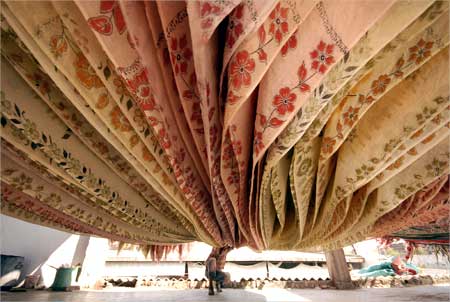

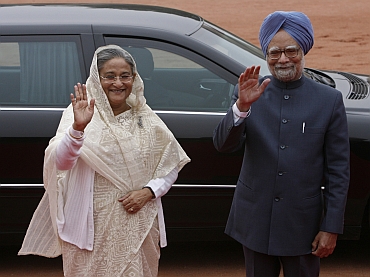
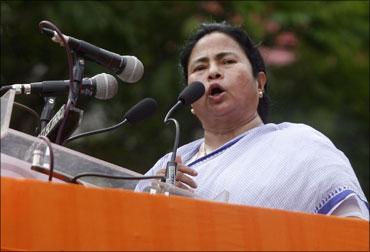
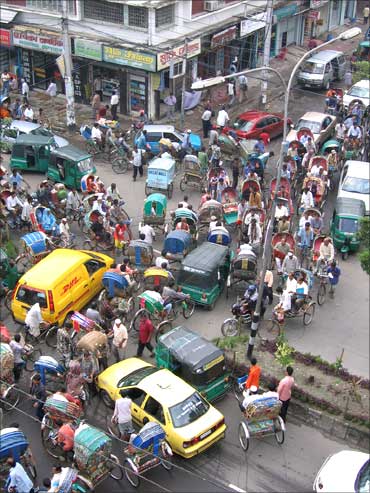
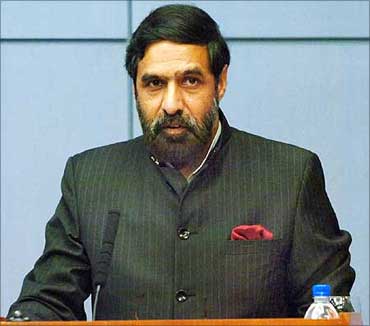
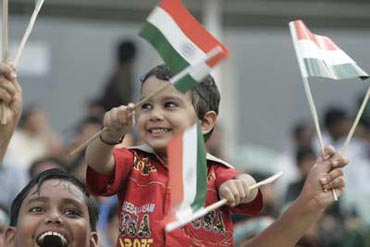


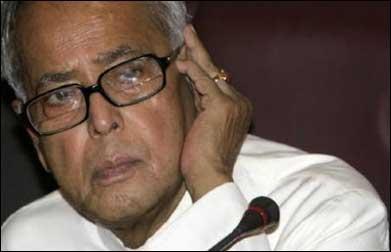

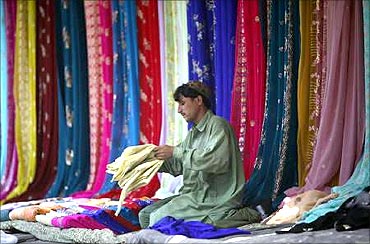

article